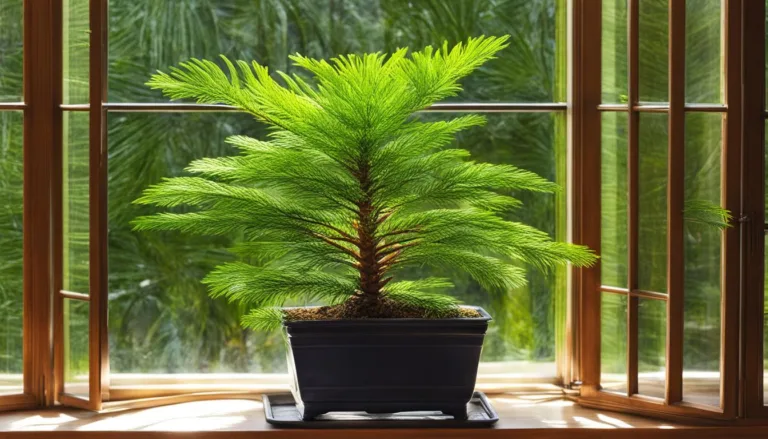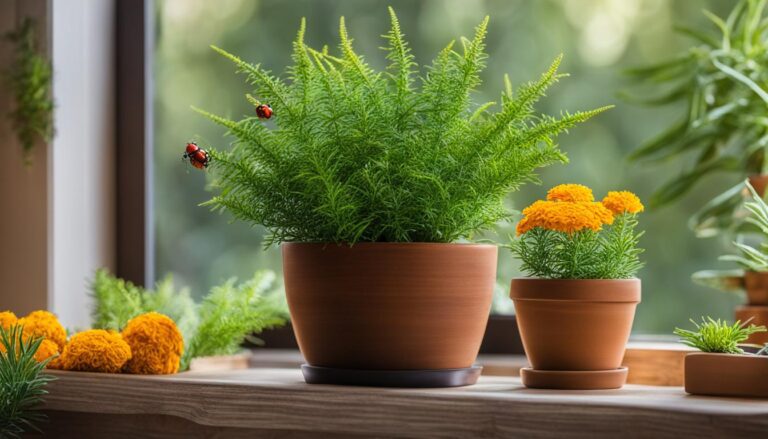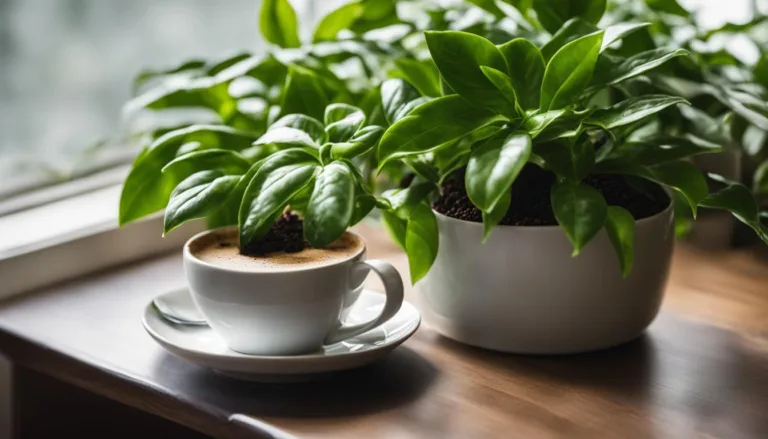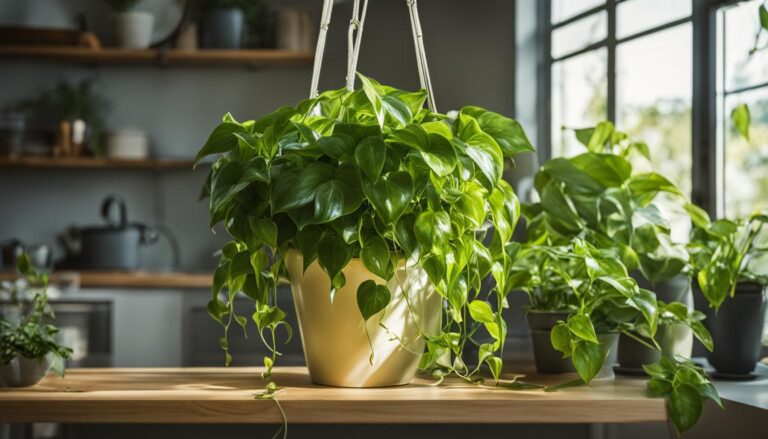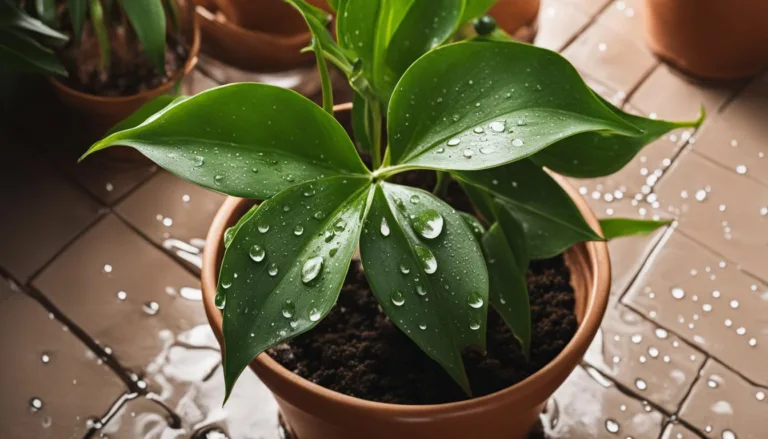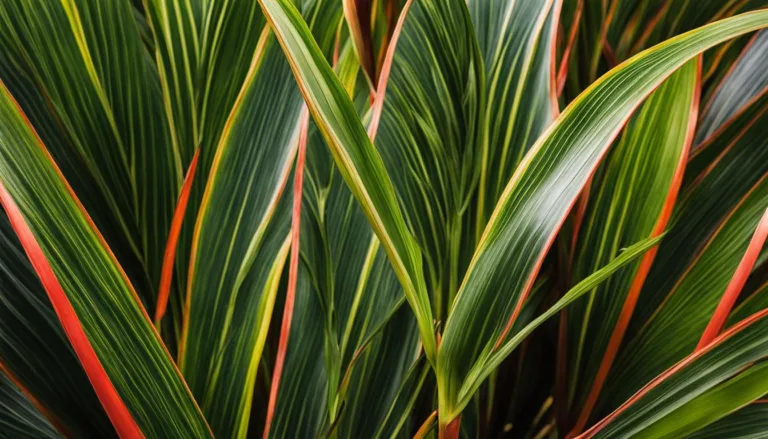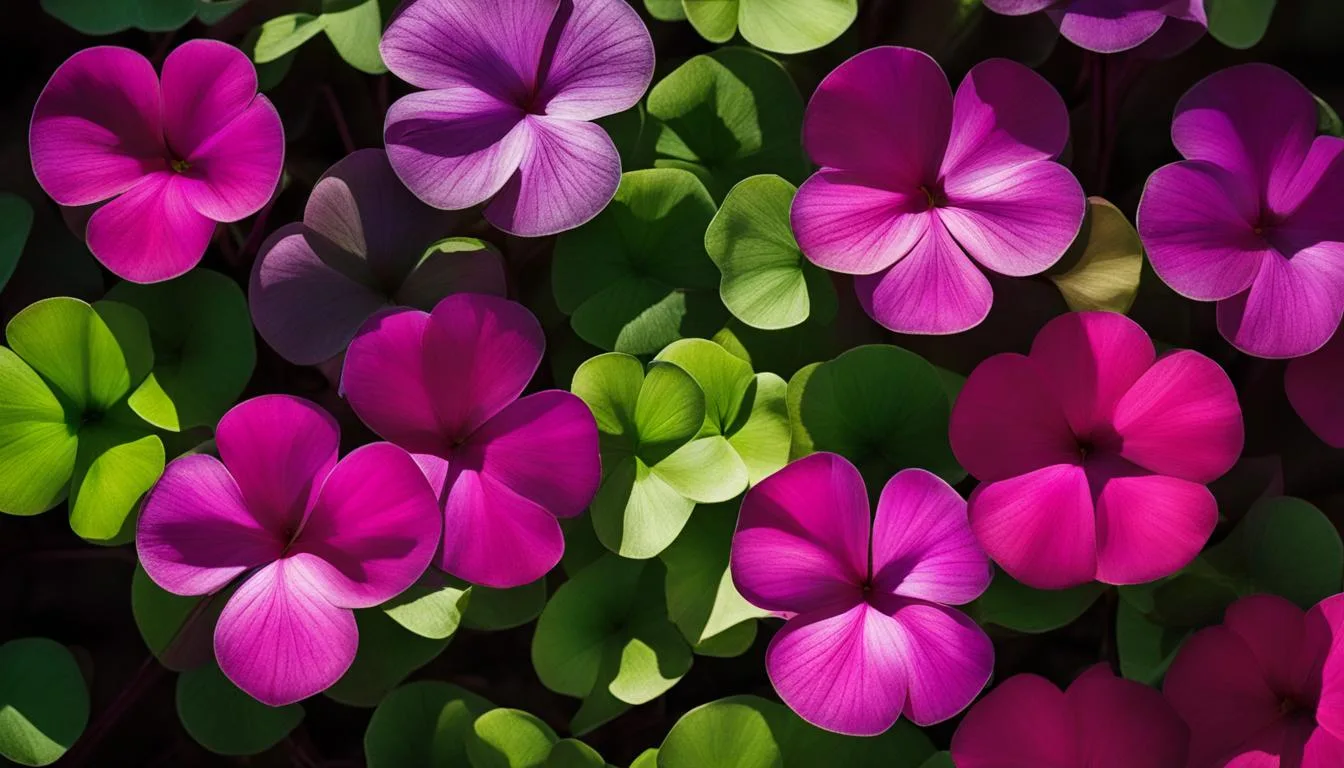
Greetings, fellow plant enthusiasts! Today, I want to delve into the wonderful world of Oxalis plants. With over 800 species in the Oxalis genus, these stunning plants have captured the hearts of many.
From their vibrant colors to their unique leaf-drooping phenomenon, there’s so much to learn and appreciate about these beauties.
Key Takeaways
- Oxalis plants are native to tropical climates and are known by various names, including Wood Sorrels and False Shamrocks.
- The most popular Oxalis species cultivated as a houseplant is the Oxalis triangularis.
- Understanding the care requirements of Oxalis plants is crucial for their well-being. They prefer bright indirect to direct light, regular watering, and can tolerate different humidity levels.
- There are various types of Oxalis plants, each with its own unique characteristics, such as different leaf and flower colors.
- Oxalis plants can experience common problems like overwatering, root rot, and spider mite infestation. Taking preventive measures and providing proper care is essential.
Understanding Oxalis as a Houseplant
When it comes to houseplants, Oxalis plants are a popular choice among plant enthusiasts. With their vibrant colors and interesting leaf shapes, they add a touch of beauty to any indoor space. To ensure the best care for your Oxalis plant, here are some key practices to keep in mind.
Light Requirements
Oxalis plants thrive in bright indirect to direct light. It is best to place them near a sunny window where they can receive a few hours of sunlight each day. Avoid keeping them in low light conditions as this can result in leggy growth and a lack of vibrant coloration.
Watering and Humidity
The watering needs of Oxalis plants are relatively simple. Water your plant every 1-2 weeks when the top half of the soil feels dry to the touch. Be careful not to overwater, as this can lead to root rot. Additionally, Oxalis plants can tolerate any humidity level, so you do not need to worry about providing additional moisture.
Pest Control
One common issue that Oxalis plants can face is spider mite infestations. To prevent and treat these pests, regularly inspect your plant for any signs of webbing or tiny insects. If you notice an infestation, apply a horticultural oil according to the product instructions to eliminate the pests.
By following these best practices for Oxalis plant care, you can ensure the health and vitality of your houseplant. Remember to provide adequate light, water appropriately, and monitor for any potential pest issues. With proper care, your Oxalis plant will thrive and continue to bring joy to your home.
Oxalis Plant Types
When it comes to Oxalis plants, there is a wide variety of options to choose from. Each type of Oxalis plant has its own unique characteristics, making them a popular choice among plant enthusiasts. Here are some popular Oxalis plant types and tips for growing them successfully.
Oxalis triangularis
Oxalis triangularis, also known as the Purple Shamrock or False Shamrock, is a stunning plant with deep purple leaves. It is a popular choice for indoor gardening due to its vibrant color and unique triangular-shaped leaves.
This plant thrives in bright indirect light and should be watered when the top inch of the soil feels dry. With proper care, the Oxalis triangularis can add a touch of elegance to any space.
Oxalis versicolor
Oxalis versicolor, commonly known as the Candy Cane Sorrel, is a visually striking plant with pink and white striped petals. It is best grown in partial shade and well-draining soil.
This Oxalis plant requires regular watering, allowing the soil to slightly dry out between waterings. The Candy Cane Sorrel can be a beautiful addition to your garden or indoor plant collection.
Oxalis hirta
Oxalis hirta, also called the Hairy Wood Sorrel, is a delicate plant with bright yellow flowers. It is a low-growing variety that spreads quickly, making it an ideal ground cover plant. The Hairy Wood Sorrel thrives in full sun to partial shade and prefers moist but well-draining soil. With its vibrant flowers and low-maintenance nature, the Oxalis hirta is a popular choice for garden borders and rock gardens.
| Type | Common Name | Characteristics |
|---|---|---|
| Oxalis triangularis | Purple Shamrock | Purple leaves, triangular shape |
| Oxalis versicolor | Candy Cane Sorrel | Pink and white striped petals |
| Oxalis hirta | Hairy Wood Sorrel | Bright yellow flowers, low-growing |
These are just a few examples of the many Oxalis plant types available. Each type has its own specific care requirements, so it is important to research and understand the needs of the specific Oxalis plant you choose to grow. With proper care and attention, these beautiful plants can thrive and bring joy to any garden or indoor space.
Common Problems and Solutions
Oxalis plants are generally easy to care for, but they can experience some common problems. By understanding these issues and implementing the necessary solutions, you can ensure the health and vitality of your Oxalis plants.
Disease and Pest Control
One common issue with Oxalis plants is the presence of diseases and pests. Spider mites are a frequent problem that can cause discoloration and damage to the leaves.
To combat this, regularly inspect your plants for any signs of infestation and treat them with neem oil, a natural and effective pesticide. Additionally, fungal infections such as powdery mildew can affect Oxalis plants. If you notice any white powdery substance on the leaves, remove the affected leaves and treat the plant with a fungicide.
Improper Watering
Overwatering or underwatering can lead to various issues in Oxalis plants. Overwatering can cause root rot and yellowing of the leaves, while underwatering can result in wilting and browning of the leaves.
It is essential to water your Oxalis plants properly by checking the moisture level of the soil. Allow the top inch of the soil to dry before watering, and avoid leaving your plants in standing water.
Adjust your watering schedule accordingly, ensuring a balance between hydration and avoiding excessive moisture.
Environmental Factors
Oxalis plants are sensitive to their environment, and certain conditions can affect their growth and health. Lack of new growth may indicate that the plant has gone dormant and requires light fertilization and proper watering to stimulate growth.
Oxalis plants require bright indirect light, and insufficient light exposure can lead to leggy growth and leaf drop. Ensure that your plants receive adequate sunlight or provide artificial grow lights if necessary.
| Common Problems | Solutions |
|---|---|
| Disease and pest infestation (e.g., spider mites, powdery mildew) | Treat with neem oil for pests and fungicide for fungal infections |
| Overwatering | Allow soil to dry between waterings and avoid standing water |
| Underwatering | Water when the top inch of soil is dry and adjust watering schedule |
| Lack of new growth | Fertilize and water properly to stimulate growth |
| Insufficient light exposure | Provide bright indirect light or use artificial grow lights |
Oxalis Plant Care: Precautions and Toxicity
When caring for Oxalis plants, it’s important to be aware of certain precautions and the potential toxicity they pose. Although these plants are beautiful and add vibrancy to any space, they can be harmful to pets if consumed. It’s essential to keep Oxalis plants out of reach of small children and animals to ensure their safety.
If you suspect that your pet has ingested any part of an Oxalis plant, it’s crucial to contact a veterinarian immediately for further guidance. They will be able to provide appropriate advice and treatment if necessary. It’s better to err on the side of caution when it comes to the well-being of our furry friends.
By taking proper precautions and keeping Oxalis plants away from pets and children, you can enjoy the beauty of these plants without worrying about any potential harm. Remember to always prioritize safety when it comes to plant care and ensure that your home remains a safe environment for all.
What is Oxalis?
Oxalis is a diverse genus of plants belonging to the family Oxalidaceae. With over 550 species found across the globe, Oxalis plants are known for their charming trifoliate leaves and colorful flowers. They are commonly referred to as shamrocks, love plants, or sorrels.
The leaves of Oxalis plants can range in color from vibrant purple to lush green, with some varieties displaying bicolor or variegated patterns. The flowers of certain Oxalis species add another layer of beauty, with delicate petals in shades of white, pink, yellow, or red. These plants are a visual delight and can instantly brighten any indoor or outdoor space.
One unique characteristic of Oxalis plants is their ability to fold their leaves down at night and close their flowers. This phenomenon, known as nyctinasty, adds a touch of whimsy to their already captivating presence. It’s a fascinating sight to behold as the plants respond to darkness by gracefully folding their leaves.
| Oxalis Plant Types | Description |
|---|---|
| Oxalis triangularis | This species is known for its striking purple leaves and pink or white flowers. |
| Oxalis versicolor | Also called the candy cane sorrel, this Oxalis has unique bicolor petals in shades of pink and white. |
| Oxalis hirta | With its fuzzy leaves and vibrant yellow flowers, this Oxalis brings a touch of texture and brightness to any garden. |
| Oxalis oregana | This species boasts glossy green leaves and delicate pink or white flowers. |
| Oxalis adenophylla | Also known as silver shamrock, this Oxalis species features silvery foliage and delicate pink flowers. |
Each type of Oxalis plant has its own specific care requirements, so it’s important to understand the needs of the particular species you choose to cultivate. Whether you opt for the vibrant purple leaves of Oxalis triangularis or the unique bicolor petals of Oxalis versicolor, these plants are sure to bring joy and beauty to your home or garden.
Optimal Growing Conditions for Oxalis
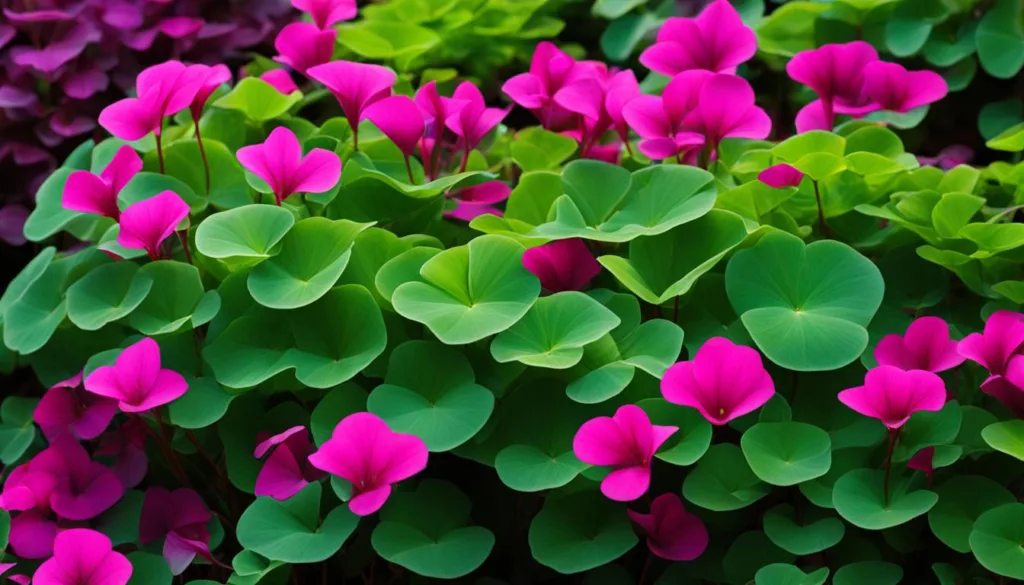
Creating the optimal growing conditions for your Oxalis plants is key to their health and vitality. These plants prefer cool summers and mild winters, making them well-suited for indoor environments. To ensure the best care for your Oxalis plants, follow the tips below:
Light
Oxalis plants have specific sun exposure requirements. Most species prefer bright indirect light in the morning and afternoon shade. Placing your Oxalis plants near a window with filtered sunlight is ideal. Avoid exposing them to direct sunlight, as it can scorch their delicate leaves.
Soil and Water
Oxalis plants thrive in well-draining soil with a slightly acidic pH. It’s important to choose a potting mix that allows excess water to drain away. Overwatering can lead to root rot, so it’s crucial to allow the soil to dry out between waterings. Check the moisture level by inserting your finger about an inch into the soil. If it feels dry, it’s time to water your plant.
Temperature
Oxalis plants prefer temperatures between 60 and 75 degrees Fahrenheit. Avoid exposing them to extreme heat or cold, as it can stress the plants. Keep them away from drafts or heaters, as sudden temperature changes can negatively impact their growth.
Fertilizer
Oxalis plants do not require heavy fertilization. In fact, too much fertilizer can lead to excessive foliage growth at the expense of flower production. Use a balanced, water-soluble fertilizer diluted to half the recommended strength once a month during the growing season.
Humidity
Oxalis plants can tolerate any humidity level, but they thrive in moderate to high humidity. If you live in a dry climate or during the winter months when indoor humidity is low, you can increase humidity around your plants by placing them on a tray filled with water and pebbles.
| Optimal Growing Conditions for Oxalis Plants | Recommended Range |
|---|---|
| Light | Bright indirect light with morning and afternoon shade |
| Soil | Well-draining, slightly acidic soil mix |
| Water | Allow soil to dry between waterings |
| Temperature | 60-75 degrees Fahrenheit |
| Fertilizer | Use balanced, water-soluble fertilizer diluted to half the recommended strength once a month |
| Humidity | Moderate to high humidity |
By providing the optimal growing conditions for your Oxalis plants, you can ensure their health and promote beautiful foliage and blooms. Remember to monitor their light, soil, water, temperature, fertilizer, and humidity needs to create a thriving environment for these charming plants.
Propagation and Care Tips
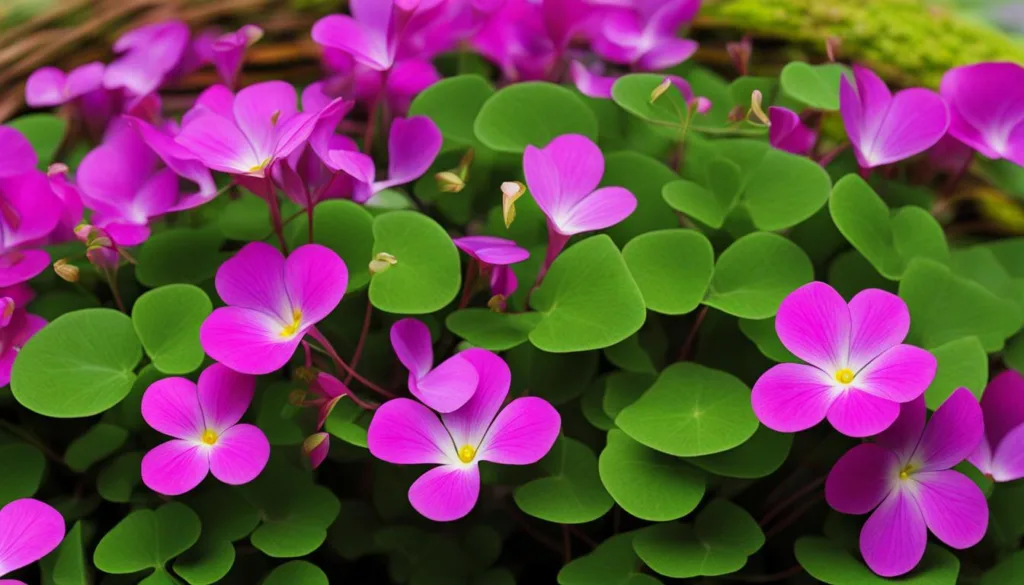
When it comes to propagating and caring for Oxalis plants, there are a few key tips to keep in mind. One popular method of propagation is through division. To do this, carefully separate clumps of the plant into individual corms, making sure each division has roots and a green shoot. Transplant the individual seedlings with the crown slightly above the soil level for optimal growth.
If you prefer to start corms in pots, choose a shallow container with a well-draining soil mix. Plant the corms and keep them at a consistent moisture level. It is important to divide potted Oxalis plants annually or move them to larger pots as they grow.
During the dormancy period, it is crucial to withhold water and fertilizer to allow the plants to rest and recharge. This helps maintain the long-term health of Oxalis plants and ensures they continue to thrive.
To help you better understand the propagation and care tips for Oxalis plants, here is a table summarizing the key points:
| Propagation Method | Care Tips |
|---|---|
| Division | – Separate clumps into individual corms – Ensure each division has roots and a green shoot – Transplant with the crown slightly above soil level |
| Potted Corms | – Use a shallow pot with well-draining soil mix – Keep at a consistent moisture level – Divide or move to larger pots as needed |
| Dormancy Care | – Withhold water and fertilizer – Allow the plant to rest and recharge |
By following these propagation and care tips, you can ensure that your Oxalis plants thrive and bring beauty to your indoor or outdoor space. Remember to provide the specific care required for each Oxalis plant type and address any common problems that may arise to keep your plants healthy and vibrant.
Troubleshooting Oxalis Plant Issues
In my experience caring for Oxalis plants, I have come across a few common issues that can affect their health and growth. By understanding these problems and their solutions, you can ensure that your Oxalis plants thrive and provide you with their beautiful foliage and flowers.
Spider mites and fungal infections
One of the main challenges you may face with Oxalis plants is dealing with spider mites and fungal infections. These pests can be a nuisance, causing damage to the leaves and stunting the plant’s growth.
To prevent spider mites, regularly inspect your plants and apply neem oil as a preventive measure. If you notice signs of a fungal infection, such as yellow or brown spots on the leaves, you can treat it with a suitable fungicide.
Proper dormancy for blooming
Another important aspect of caring for Oxalis plants is providing them with the right conditions for dormancy. Ensuring a properly timed dormancy period is crucial for the plants to bloom.
Factors like sun exposure, heat levels, and moisture can affect the flowering process. To promote blooms, it is essential to understand the specific needs of your Oxalis plant and provide the necessary care during dormancy.
Addressing environmental factors
In addition to pests and dormancy, environmental factors play a significant role in the overall health of your Oxalis plants. Providing the optimal growing conditions, such as the right sun exposure, well-draining soil, and appropriate watering, is vital.
Oxalis plants prefer bright indirect light in the morning and afternoon shade. Being mindful of these factors and adjusting your care routine accordingly can help prevent and address common problems.
By troubleshooting any issues that arise and taking proactive measures to prevent problems, you can create a favorable environment for your Oxalis plants to thrive. Remember to observe your plants closely, supply the necessary care, and enjoy the beauty they bring to your indoor or outdoor space.
FAQ
What is the most popular species of Oxalis cultivated as a houseplant?
The most popular species of Oxalis cultivated as a houseplant is Oxalis triangularis.
How often should I water my Oxalis plant?
It is recommended to water your Oxalis plant every 1-2 weeks when the soil is halfway dry.
What temperature range is ideal for Oxalis plants?
Oxalis plants prefer temperatures between 65°F-85°F.
How can I prevent spider mite infestation on my Oxalis plant?
Spider mite infestation can be prevented by regularly checking for pests and using neem oil as a treatment.
Are Oxalis plants toxic to pets?
Yes, Oxalis plants are toxic to pets if consumed. It is best to keep them out of reach of small children and animals.
How often should I divide my potted Oxalis plant?
Potted Oxalis plants should be divided annually or moved to a larger pot to ensure their health.
How can I address common problems like yellow leaves and wilting in my Oxalis plant?
Yellow leaves and mushy stems indicate overwatering, while wilting brown leaves can be a sign of underwatering. Adjust your watering and humidity levels accordingly.
What is nyctinasty?
Nyctinasty is a leaf-drooping phenomenon that Oxalis plants exhibit in response to darkness.
How can I propagate my Oxalis plants?
Oxalis plants can be propagated through division by separating clumps into individual corms.
What are some common issues that Oxalis plants may experience?
Oxalis plants are susceptible to spider mite infestation, root rot from overwatering, and fungal infections. Proper care and preventive measures can help address these issues.

